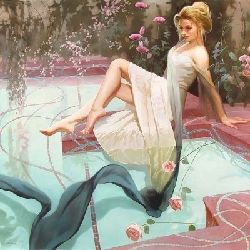Svetlana Valueva Biography

Svetlana Valueva
| Born | 1965 |
| Birthplace | Pokrovsk, Russia |
| Home | St. Petersburg, Russia |
| Style | Romantic Impressionist |
Valueva, a native of Moscow, portrays women who live in a mystical world, surrounded by bizarre forms, signs and objects: a world real to them, however steeped in fantasy.
She began painting as a toddler. Her father, an artist, became her first and most important teacher, encouraging her to paint alongside him in his studio.
Thirteen years of state structured curriculum established Valueva's art and drawing skills in "social realism." In 1975, at age 9, she received the Gran Prix at the annual International Exhibition in Delhi, India, a juried exhibition of paintings by 150,000 children from 35 countries. She placed third in the same competition in 1977, won the gold (Gran Prix) again at age 13.
In 1977, a documentary featuring Valueva and other young achievers in art was shown in movie theaters across Russia. The same year she was highlighted on the front page Soviet Union, a popular monthly magazine. Few realize such fame in their lifetime, much less as a youngster.
In the Seventies, the only style permitted for Soviet artists remained social realism. The first time Valueva opened art books and was exposed to images by Klimt, Alfons Mucha, Sargent, and Alma-Tadema, she was stunned. She realized that her passion lay with those artists, and not with the "acceptable" realism.
Valueva continued to paint the obligatory art for school, but at home she allowed her true style to
emerge. Her father had given her his studio, and she lived and worked there. Soon a steady
stream of people interested in her emerging style--rather than "official" art --flocked
to her studio. Before graduation she began to sell her "hidden" work to dealers in
Belgium, France and Poland.
Valueva had her first solo show in a Moscow gallery in 1993. Influenced by photographs left by her great grandmother, a ballerina at the Marinsky (Kirov) Ballet Theater, and by her great grandfather, an officer in the czar's army, the twelve paintings she created for the exhibit generated immediate interest. A Japanese publisher purchased all of them, and requested more.
In 1995 she was commissioned by The Bolshoi Theater for a ballet collection. Invited to
rehearsals by the art director of the company, Valueva created 15 painting that are on
permanent display in the Bolshoi foyer.
Nostalgia for the elevated, magnificent "silver age" of Russia has drawn her to
the past, a period known in the West as Art Nouveau, Jugendstil, or Liberty. This is where
the characters of Valueva's paintings are destined to dwell.
"It's hard today to trace back the origins of my affinity for Art Nouveau,” says the artist. “I feel I was destined to love this art from birth. This elaborate, refined, truly aristocratic style, regardless of subject matter, captures the fragility of all earthbound existence.”



